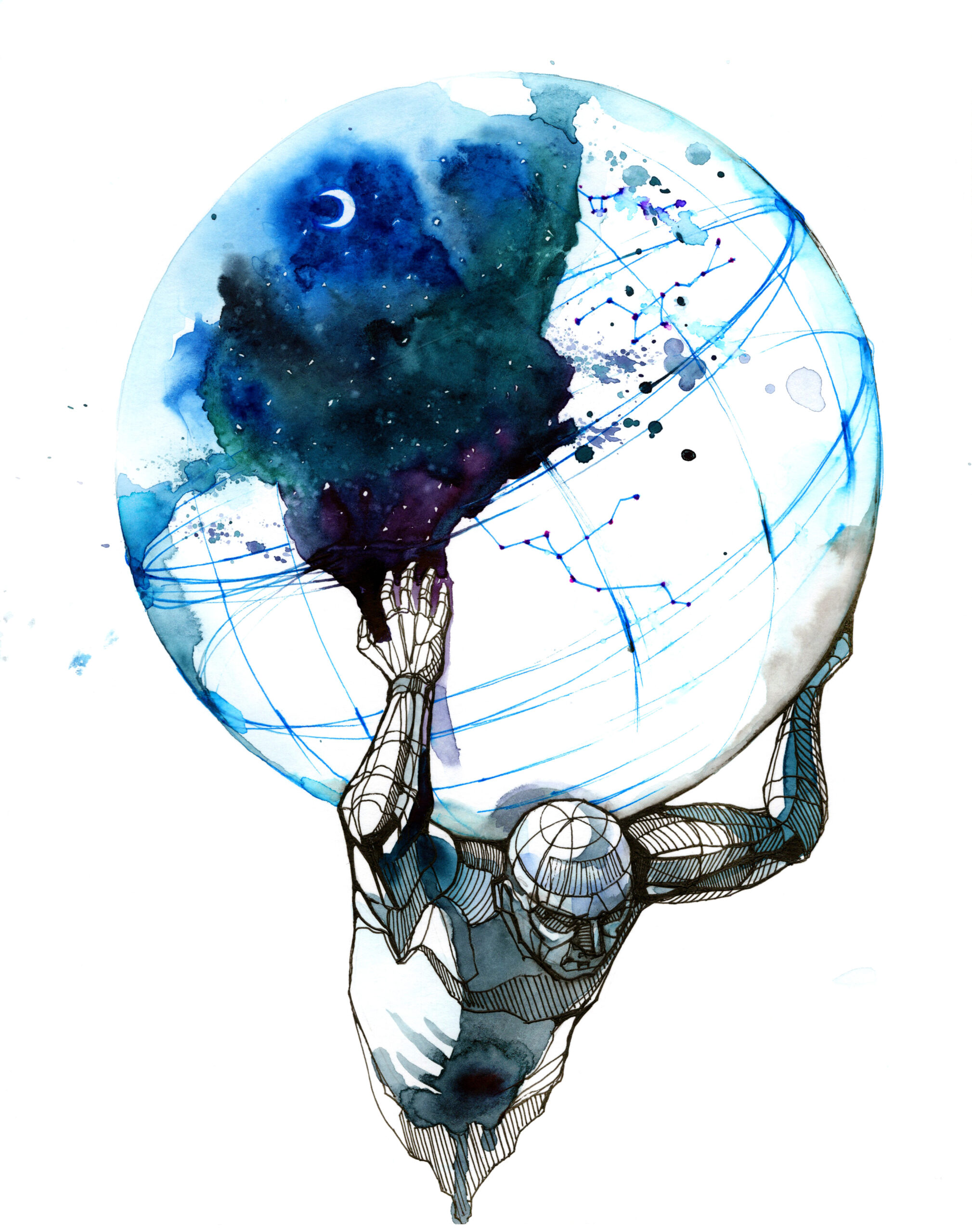
The weight of the world on our shoulders.
It’s true, women in particular struggle with neck and shoulder problems. Part of our problem is that the thoughts that swirl around in our minds constantly can weigh heavily upon us.
Is it not in our nature to take on others pain and struggle? With worry and concern, and a plethora of responsibilities, it can be quite a challenge to hold our heads up.
Never fear, yoga is here!!
Mind-Body Approach
My approach here is twofold. The Mind-Body connection always gives us a lot to consider.
First, anatomically, we must address the very real and present concerns of alignment and poor postural habits. As a result of:
- slumping over a computer
- constantly gazing down at a smart phone
- the natural aging process
- and our personal, poor postural tendencies…
…we have become very weak in the upper back and abdominal muscles.
Our upper backs burn with the effort to “sit up straight” and results in us wanting to spend more time slumping, simply to relax.
Secondly, we must look at our emotional and mental state. To understand energetically what is happening to create this weight, this pain, this ache in this area.
Anatomy and Alignment
Our head is heavy. Our necks are thin by comparison. We are upright beings.
Already we have an architectural miracle going on that we don’t tip over at a stiff breeze!
Part of the stability and ease that we can experience in our necks comes from the stability and functional strength of the shoulder girdle, and the mobility of the shoulder joint.
The shoulder girdle is made up of your clavicles (collar bones) and the scapulae (shoulderblades). See Figure 1.
Another important bony landmark here is the manubrium, the upper portion of the sternum (breast bone) that the collar bones articulate with. This is the Windsor knot of our necktie, if you will. See Figure 2.
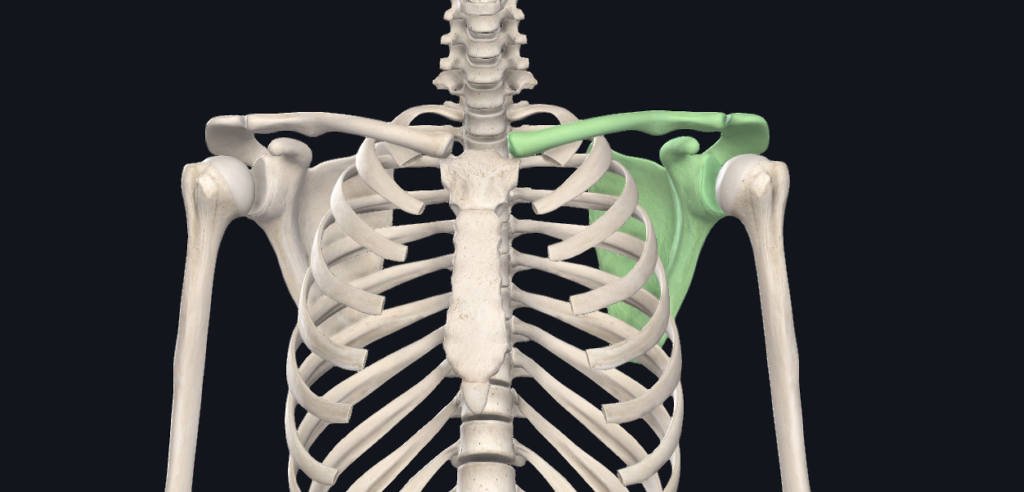
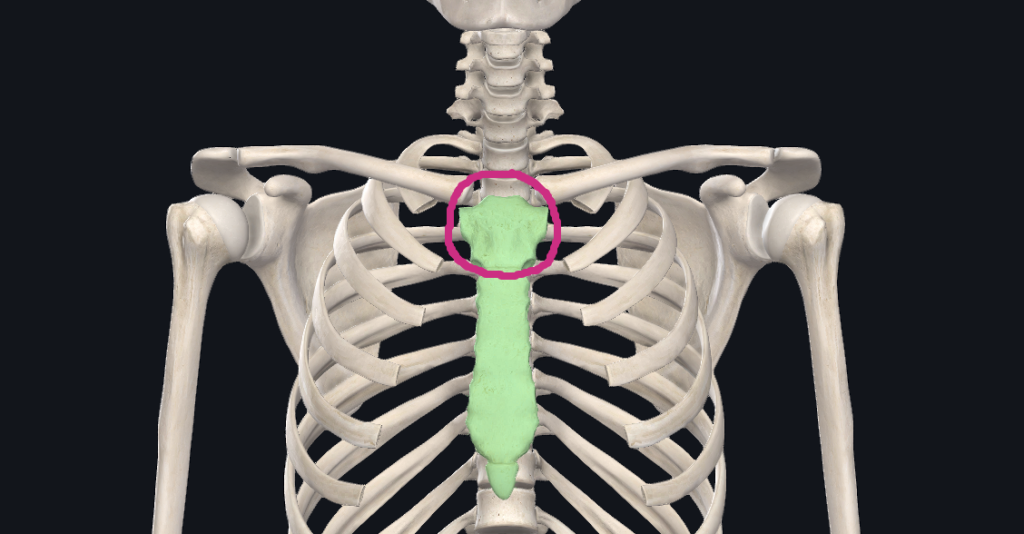
The shoulder joint is comprised of the humerus (upper arm bone) into the glenofasso of the scapula. See Figure 3.
The shoulder joint is rather shallow, especially in comparison to our other ball and socket joint, the hip. This allows for a lot of mobility in the shoulders, which we need in our daily lives.
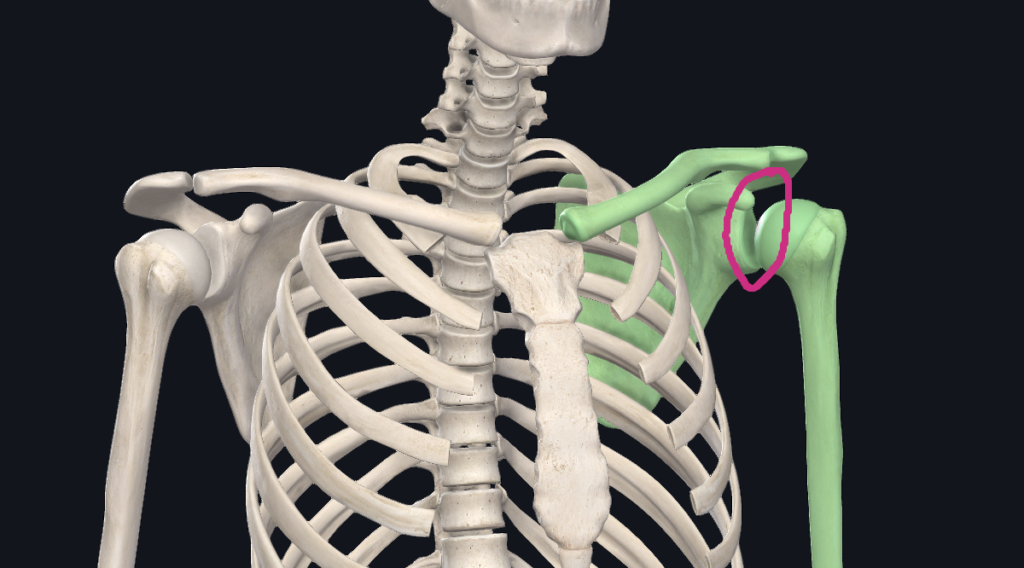
Beyond the mundane of our lives, this mobility means we can throw balls with a huge wind-up, reach our arms over head, or clasp and twist our arms behind us. They are expressive – reaching out in compassion to embrace, thrown out to the sides to protect, or in front of us to defend.
The easy movement we have in our shoulder joint is something we often take for granted, and begin to notice just how important it is when it is hurting and suddenly we are limited in some way.
Trouble often comes when the free mobility of this joint is not balanced by stability of the shoulder girdle with the surrounding muscles of the rotator cuff and upper back.
The Problems
For optimal daily upper back posture, the shoulder blades should be in the center of the back ribs, closer to the spine than further away. This enables the upper arm to release down from the shoulder joint more toward the center/back side of the body.
In this position, the front of the chest is fairly open, and respiration is easy. The head is well balanced on top of the cervical spine (the vertebrae of the neck), and the upper body is in a better posture. Please note that this isn’t exactly a neutral posture. It is more exaggerated than anatomically neutral, in an effort to counteract the toll of modern living.
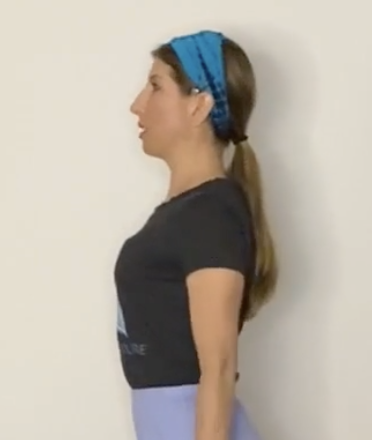
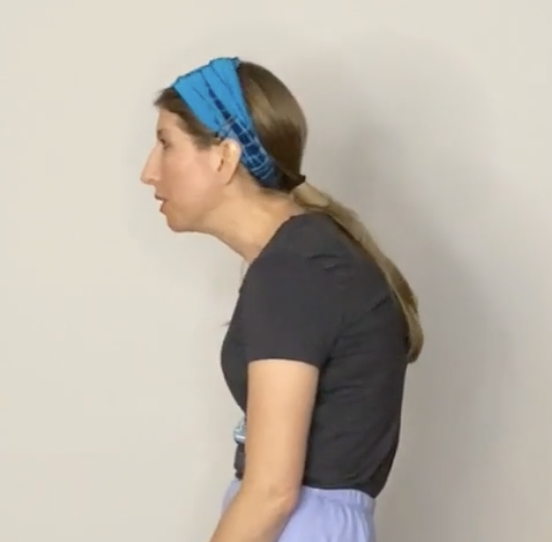
However, most of us simply do not engage our shoulder blades on a regular basis. This results in them moving away from the spine, the upper arms hanging forward of the body, the chest collapsing and the head also moving forward.
The classic slump.
Our kinetic chain sends problems up and down the body when we experience this type of posture.
A common one, especially for us women, is hyperkyphosis of the upper thoracic spine, also know as a hunchback or dowager’s hump.
In the case of this hyperkyphosis, fatty deposits may be laid down in the base of the neck and upper back over time. This is the body’s way of compensating for the extra weight of the head leaning forward. Women with this condition complain about tight shoulders, headaches and feel self-conscious about the aesthetic look.
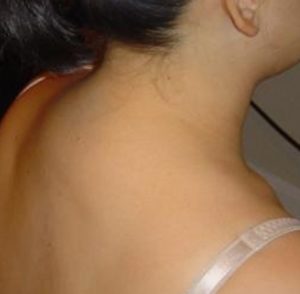
Another problem common in this region, aside from hyperkyphosis, is muscular neck pain, stemming from the base of the skull. This can result in headaches deep in the back skull, and sometimes tingling nerve pain that can travel all the way to the fingertips.
Additionally, lots of women that I’ve worked with have experienced pain in the muscles of shoulder joint, especially the deltoid. Or, you may have frozen shoulder (adhesive capsulitis)! If you have ever experienced this, you know it is very painful and your range of motion is severely limited.
Though each of these problems have their own unique particulars, and should be dealt with as such, most of us can experience tremendous improvement with the following basic guidelines.
Finding Solutions in Stability
First we must find proper alignment in this area. Such that the shoulder blades are well placed on the upper back, the humerus is in alignment with the center of the body, and the back of the skull is in alignment with T1 (the first thoracic vertebra).
But a body used to poor habits will slip right out of alignment.
In yoga, we work constantly to reinforce these new, properly aligned habits, with props and in nearly every asana (pose). Additionally, I encourage all of my students to spend time off the mat in their daily lives to continue to practice what we’ve learned in class. In fact, many a student has told me that they can hear my voice calling “Shoulder Blades!!” as they go about their business. Ah, what a proud professional moment for me that is.
This strategy often works like magic. It is simple, but not easy. You work to habituate yourself to draw the shoulder blades into the center of the upper back, and allow all arm movements to be supported by this placement. It is not that the shoulder blades aren’t moving dynamically with what you are doing, but rather, they keep coming back to a new “home” position – which is a lot closer to the spine than most of us are used to.
The upper back muscles (particularly the Trapezius and Rhomboids) and the rotator cuff muscles (including the Supraspinatus, Infraspinatus, Subscapularis, and Teres Minor) are key players here.
As we strengthen these stabilizing muscles, they don’t fatigue so quickly in our yoga practice and are ready to engage in our regular life as well. This then becomes our job to keep reminding ourselves to return to this “home” position. The more we practice it, the more it gets engrained and becomes a strong neural pathway.
Finding Solutions in Mobility
Likewise, it is not enough to simply stabilize the joint…as stated at the beginning of this article, this joint is made for moving! Maintaining and increasing healthy mobility in the shoulder joint and the upper back is key to feeling free and open in the neck, chest and upper back.
Even a simple pose like Urdhva Hastasana, Upward Arms Pose, when executed with awareness and precision is one of the greatest poses for working on mobility and stability in the arms and upper back. As you work to fully straighten your arms, you tone the muscles of the arms and shoulders. Further, bringing the upper arm bones back in alignment with the ears challenges the mobility of the shoulder joint, especially as you stabilize in the core of the body.
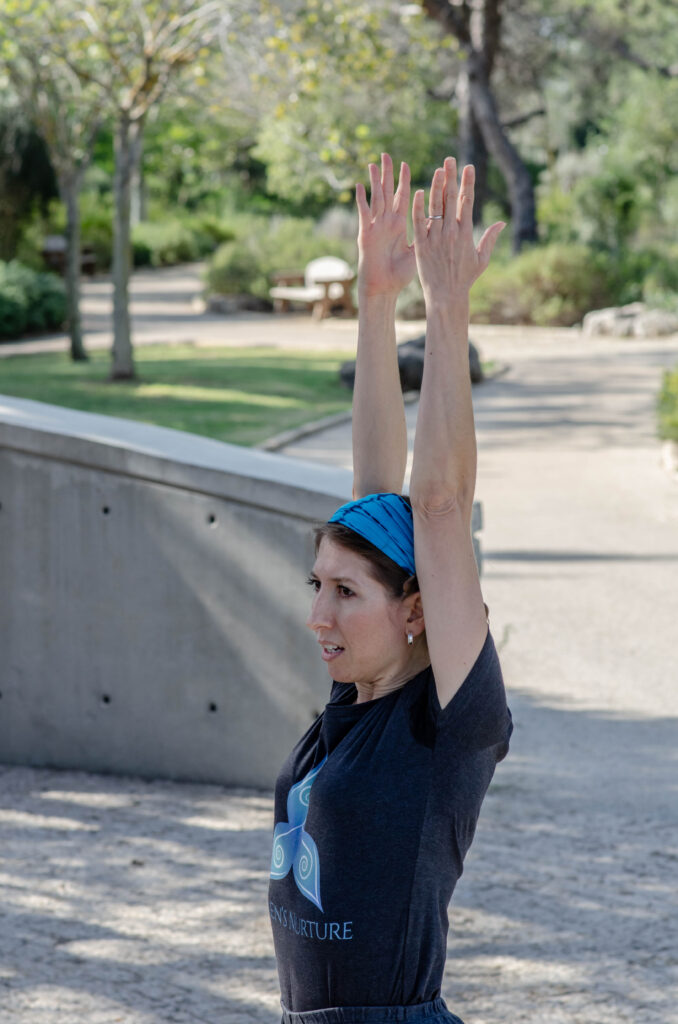
Activating the shoulder blades after the arms are in the raised position has the further benefit of lengthening the dorsal thoracic spine. Yeah, that area of the hunchback between the shoulder blades begins to move into the body, instead of humping out in hyperkyphosis. Nice, right?
Obviously, there is so much more that we can and do to correct our posture in yoga. This is just the tip of the iceberg. Advancing in your yoga practice will introduce more back bends, and they further target this region to bring greater mobility yet.
If you are suffering from any of the above issues I listed, please find a qualified Iyengar Yoga Instructor in your area and begin finding relief!
Organic??
It’s not just your vegetables that are organic, you are too! Our postural problems in the neck, shoulders and upper back have a big impact on two major organs. Your lungs and your heart. (The kinetic chain also means more things are affected, but let’s start here.)
With our upper body properly aligned, we often notice that our breathing is deeper and more full and that our mood is lighter.
This is no coincidence. It is well documented that your posture and mood are connected. You can even try a little experiment yourself…2 minutes of slumped posture, versus 2 minutes with standing tall. How do you feel? Notice a difference?
There are those that think the increase in depression in recent years is partially because of these slumping problems, drawing our faces down to screens/phones for so much of our life. In my opinion, these lovely devices are culprits in more than just slumping -related depression, but that’s a topic for another time.
One of the benefits of an improved posture is that it only happens by our increased awareness and effort in this area. This increased awareness and mental and physical exertion is contagious and has a spillover effect. We may be more conscious in our breath. We may notice our feelings more. We may notice the connection between our breath and our thoughts.
All this noticing, all this consciousness also tends to spread to others. You may feel more compassion and kindness to others.
And why not? It makes sense. Your heart center is opening!
The Chakras
The heart chakra, Anahata, is powerfully felt in the chest. When it is flowing, you can easily tap into emotions like love and compassion, and feel connection to yourself and those around you. In fact, to the entire world around you, including nature, people, animals, and even inanimate objects. It is easy to breathe and breathe deep. You feel calm and confident.
When it is blocked, you feel much more closed off. You may easily experience anger, jealousy, loneliness and have difficulty trusting. Further, your body will speak to you about this with problems in this region, ranging from muscular-skeletal issues in the arms, shoulders and upper back, as well as other ailments of the heart, circulation and lungs. They may present as chronic issues, like high blood pressure, or frequent infections, bronchitis, etc.
What is This Telling Me?
I think that the messages our bodies send us are guides to deep wisdom and growth. They are almost never very serious if we listen and act early. If we try to look at them from all angles.
This is hard for most of us. We live in a world that isn’t particularly holistic. It is more compartmentalized and segregated. But we are a whole beings. Every single one of us.
When we understand, deeply and completely, that everything is connected, we can often begin to put together the puzzle pieces of our problems. And in fact, those body messages can help us to suss out deeper issues that might have stayed buried otherwise.
Only you can really know why you are experiencing pain or discomfort. Though sometimes alignment and posture issues are just that, a fault of our modern day living, I would suggest looking at where you are energetically, emotionally and spiritually as well. What sorts of stresses are you facing, what are you worrying about?
As I said in the very beginning of this article, the weight of the world is sometimes resting on our shoulders. And that can be a very heavy load indeed for our hearts.
Lighten the Load
Community and support from friends and family are a great way to lighten your load. Sharing with others your struggles is a big step in releasing the weight of life’s stresses. A pain shared is a pain halved.
Practicing yoga and working to correct poor postural habits is a fantastic way to work from the outside in. Yoga can be like magic in that way. We are often drawn to yoga initially for some help with a physical ailment. Before you know it, energy is moving and getting unblocked and you just start feeling better! Be sure to pay attention to your breath and enjoy the process.
Finding gratitude, for real. No matter how low you may be feeling, how much lack you experience, I guarantee you that there is still what to be grateful for. There are others far, far, far worse off. Practice changing your perspective, and noticing the small and big things that are so wonderful in your life. The more you do this, the easier it becomes, and then you notice more and more things…when you tap into the flow of gratitude, it leads to the flow of abundance.
And this leads me to my final thought here. Give. Give, give, give, GIVE!!!!! Nothing opens your heart more than giving. We all have something to give. It can be small or big. It may be that you give to strangers, family, or even to yourself. Get in the habit of generosity. Let it flow from the heart to the hand.
If this is hard for you, notice where you get stuck in the process. Is it fear that you won’t have enough? Is it a sense of fairness that you worked hard and others must too? Is it a belief that others with more than you should be taking care of this problem, so you’re off the hook? All of these ideas and feelings can be well justified. Try to give anyway. Even if you give under the guise of self-interest (to help open your ❤️), that’ll work.
Now, don’t go overboard here. I’m not suggesting over giving, so that you are a worn out rag by the end of the day. Everything in balance, okay? Your needs also need to be met, but the approach of generosity is actually a deep statement of trust. Trust that the energy of the heart is that it must give and it must receive, all the time. It is just like the circulatory system. Constantly flowing, constantly going in and going out of the heart, refreshing and renewing. And that is living life. When it stops, so does life.
So, sit up straight, move your shoulder blades a bit closer together, drop that weight from your shoulders, open your hands in generosity and let your heart shine!

Beautiful! For years, I had terrible neck and back pain. It took a long time for me to learn that so much of the pain was connected to anger I didn’t know how to release. As I’ve shifted my mindset, and stopped doing things that I didn’t want to do (but felt I had to do), I have had significantly less pain in those areas. Of course, I am now working to strengthen all of the muscles in this area, but without having to carry the anger, my neck and upper back regularly feel relaxed and free.
Thank you for sharing your experience Karli. How wonderful you were able to identify the mindbody connection for you in this area and that you were able to make changes that brought you ease and comfort in your life. It’s very inspiring.